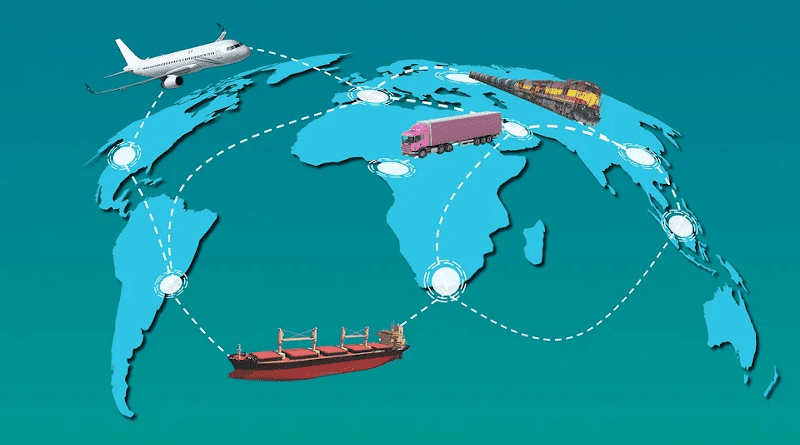China Weakens, Vietnam Losing Shine: Should India Chase Global Supply Chain Hub? – Analysis
After COVID 19 devastated the Chinese economy and Vietnam lost its shine, hopes grew for India to emerge as a leader in the global supply chain. Given that the Chinese economy plunged, investors shifted to Vietnam as a safe place for supply chain manufacturing. But overdependence on China for raw materials, intermediates and components faded Vietnam’s luster after the Chinese economy shrank. Vietnam imports inputs mainly from China, to then assemble and process and export to USA, Japan and EU.
Vietnam growth of the supply chain is intertwined with Chinese growth. As a result, when China’s predominance in supply chain manufacturing dipped, resulting in thousands of factories closing down, this had a major impact on Vietnam’s manufacturing supply chain manufacturing. Imports from China accounted for nearly 32 percent of total imports for Vietnam in 2022, most of which comprise electronic and electrical items.
Given the trilateral structure of Vietnam’s supply chain manufacturing, where China is indispensable, dependence on the country’s supply chain is vulnerable. If China grows, Vietnam rises and when China falls, Vietnam sinks.
Vietnam is an export oriented economy. Till 2022, China was the main backbone for Vietnam’s supply chain manufacture and exports. During the first 5 months of 2023, Chinese total exports to Vietnam declined by 17.5 percent over the corresponding period in the preceding year. This caused ripples on the Vietnam manufacturing supply chain, resulting in a decline on the export of supply chain. Total exports of Vietnam fell by 4.4 percent in 2023. This was primarily due to a fall in the exports of smartphones – one of the main items for exports, Vietnam News said.
Should India chase the supply chain hub, given Vietnam’s fading power for export? India is a growing economy and one of the fastest in the world. Not only this, its strategic growth has witnessed a new era of dynamism. Manufacturing outplaced the service sector to push the growth. Till now, manufacturing was fading and sthe ervice sector was the trigger for growth.
During the current fiscal year in 2023-24, manufacturing is expected to surpass the service sector to boost the GDP growth. According to Advance Estimate of GDP growth for 2023-24, manufacturing is expected to notch 6.5 percent growth, against 1.3 percent growth in 2022-23. To this end, even though the service sector is expected to record higher growth, it is expected to fall to 8.3 percent in 2023-24 from 9 percent in 2022-23 . The hyper upturn in manufacturing gives a new lease of life to supply chain manufacturing in India, at the cost of China’s dark days and the corresponding impact on Vietnam.
According to Nikkei Asia, “India can be the bigger winner in the supply chain shift from China”. Further, it said, “When India and USA work together on semiconductor devices and critical materials, it helps the world in making the supply chain more diverse”. Recently, Micron Technology, USA, formed a joint venture deal with the State Government of Gujarat to establish a semiconductor unit worth Rs 2200 crore near Ahmedabad.
To this end, in terms of sustainability for supply chain manufacturing, India has an edge over Vietnam. Unlike Vietnam, India is not over-dependent on other countries. Most of the raw materials and intermediates, excepting critical materials like semiconductors, are produced in India. For instance, local value addition in manufacturing mobile phones stands at an average of 15 percent, according to Counterpart Technology Market Research.
Various policy measures were adopted to increase India’s potential for manufacturing for supply chain. Though India was not focused as alternative to China, it has several factors in its favour to edge out Vietnam.
In China, concerns were raised on India emerging as substitute for the that country’s supply chain. According to Hu Shisheng, Director, South Asia Institute, China – Institute for Contemporary Industrial Relation, “since past two years the Modi government initiated Industrial Substitution for China. There are three major aims of Modi government policy. First, introduction of PLI scheme (Production Linked Incentive), second, global search for China alternatives and third, enhancing free trade agreement routes to topple the burgeoning imports from China”. The decision of Apple of USA, decoupling from China and shifting to India, is a case in point .
India is ahead of Vietnam for its strong base for digitization. Digital capabilities increase the supply chain network visibility and improve control and coordination, according to a survey by Deloitte. India is the 4th largest nation for digitization in the world.
FDI flow in India has increased following the COVID pandemic. Countries like Vietnam, Thailand, Malaysia, Singapore and Philippines are behind India in FDI flow. FDI in most of these nations was less than half of that for India. In 2022, FDI flow in India amounted to US$49,355 million, as compared to US$17,909 million in Vietnam, US$10,034 million in Thailand, US$16,940 million in Malaysia and US$21,968 in in Indonesia, according to World Investment Report, 2023.
FDI soared in manufacturing in India. It increased by 76 percent in manufacturing sector in 2021-22 over 2020-21. The PLI scheme pinned a new hope for manufacturing growth in supply chain. Launched three years ago, it has drawn several success stories, including to leading a boost in value addition in mobile phones manufacturing. India saw a 20 percent value addition in mobile manufacturing within 3 years, against Vietnam achieving 18 percent value addition in 15 years, according to an official Press Note of government of India.
The noticeable feature of India’s supply chain industry is that it is pursued both with domestic demand and export, unlike Vietnam, which largely depends on exports and imports.

